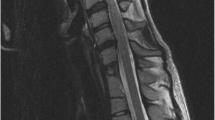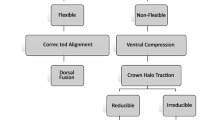Summary
We report 57 cases of the Klippel-Feil syndrome. Five had type I congenital cervical fusion, 48 type II and 4 type III. The symptoms and signs varied considerably. Patients with C2–C3 fusion often had symptoms associated with odontoid dysplasia and occipito-cervical instability. Twenty-one had progressive neurological symptoms and 19 were operated on: 3 had occiput-C3 posterior arthrodeses, 2 a single level fusion, 1 a laminectomy and anterior arthrodesis, and 13 had laminoplasties. Degenerative changes at the unfused segment and a narrow bony canal are high risk factors in the development of neurological compromise.
Résumé
Les auteurs rapportent 57 cas de syndrome de Klippel-Feil. D'après la classification de Feil, 5 des patients avaient une fusion de type I, 48 une fusion de type II et 4 une fusion de type de III. Il n'y avait pas de prévalence sexuelle notable et les symptômes étaient très variés. Les patients avec fusion C2–C3, présentaient souvent une dysplasie de l'apophyse ondotoïde avec instabilité cervicooccipitale. 21 patients ont eu des déficits neurologiques progressifs et 19 d'entre-eux ont du être opérés: 3 pour une arthrodèse postérieure occipito-C3, 2 pour une arthrodèse antérieure en un seul niveau, 1 par laminectomie et arthrodèse antérieure et 13 par laminoplasie. En plus de la pathologie dégénérative se développant au niveau du segment non fusionné, un canal cervical étroit au niveau du segment atteint de syndrome de Klippel-Feil représente un facteur de risque important de troubles neurologiques.
Similar content being viewed by others
References
Baba H, Furusawa N, Imura S, Kawahara N, Tsuchiya H, Tomita K (1993) Late radiographic findings after anterior cervical fusion for spondylotic myeloradiculopathy. Spine 18: 2167–2173
Baba H, Furusawa N, Imura S, Kawahara N, Tomita K (1994) Laminoplasty following anterior cervical fusion for spondylotic myeloradiculopathy. Int Orthop 18: 1–5
Chandraraj S, Briggs C (1992) Failure of somite differentiation at the craniovertebral region as a cause of occipitalization of the atlas. Spine 17: 1249–1251
Ducker TB (1990) Cervical myeloradiculopathy: Klippel-Feil deformity. J Spinal Disord 3: 439–444
Elster AD (1984) Quadriplegia after minor trauma in the Klippel-Feil syndrome. A case report and review of the literature. J Bone Joint Surg [Am] 66: 1473–1474
Epstein NE, Epstein JA, Zikha A (1984) Traumatic myelopathy in a seventeen-year-old child with cervical stenosis (without fracture or dislocation) and a C2–C3 Klippel-Feil fusion: a case report. Spine 9: 344–347
Feil A (1919) L'absence et la diminution des vertèbres cervicales (étude clinique et pathogénique): le syndrome de réduction numérique cervicale, Thèses de Paris
Fielding JW, Hensinger RN, Hawkins RJ (1980) Osodontoideum. J Bone Joint Surg [Am] 62: 376–383
Fielding JW, Hensinger RN, Hawkins RJ (1986) The cervical spine. In: Lowel WW, Winter RB (eds) Pediatric orthopaedics, 2nd edn. Lippincott, Philadelphia
Hall JE, Simmons ED, Danylchuk K, Barnes PD (1990) Instability of the cervical spine and neurologic involvement in Klippel-Feil syndrome: a case report. J Bone Joint Surg [Am] 72: 460–462
Hensinger RN (1992) Congenital anomalies of the cervical spine. In: Rothman RH, Simeone FA (eds) The spine. Saunders, Philadelphia
Hensinger RN, Lang JE, MacEwen GD (1974) Klippel-Feil syndrome: a constellation of associated anomalies. J Bone Joint Surg [Am] 56: 1242–1253
Jeanneret B, Magerl F (1990) Congenital fusion C0–C2 associated with spondylolysis of C2. J Spinal Disord 3: 413–417
Klippel M, Feil A (1912) Un cas d'absence des vertèbres cervicales avec cage thoracique remontant jusqu'à la base du crâne. Nouv Icon Salpétrière 25: 223–250
Lee CK, Weiss CK (1981) Isolated congenital cervical block vertebrae below the axis with neurologic symptoms. Spine 6: 118–124
Louw JA, Albertse H (1987) Traumatic quadriplegia after minor trauma in the Klippel-Feil syndrome [Letter]. S Afr Med J 72: 889–890
Nagib MG, Maxwell RE, Chou SN (1984) Identification and management of high-risk patients with Klippel-Feil syndrome. J Neurosurg 61: 525–530
Nagib MG, Maxwell RE, Chou SN (1985) Klippel-Feil syndrome in children: clinical features and management. Child Neurol System 1: 255–263
Odom GL, Finney W, Woodhall (1958) Cervical disc lesions. JAMA 166: 23–28
Ohki I, Ohta H, Saitoh A (1993) Cervical myelopathy associated with Klippel-Feil syndrome. Proc Jpn Orthop Assoc 66: S69
Pizzutillo PD (1983) Klippel-Feil syndrome. In: Bailey RW, Sherk HH, Dunn EJ et al (eds) The cervical spine. Lippincott, Philadelphia
Pizzutillo PD, Woods MW, Nicholson I (1987) Risk factors in the Klippel-Feil syndrome. Orthop Trans 11: 473
Prusik VR, Samberg LC (1985) Klippel-Feil syndrome associated with spinal stenosis: a case report. J Bone Joint Surg [Am] 67: 161–164
Ritterbusch JF, McGInty LD, Spar J, Orrison WW (1991) Magnetic resonance imaging for stenosis and subluxation in Klippel-Feil syndrome. Spine 16: S539-S541
Sherk HH, Dawoud S (1981) Congenital os odontoideum with Klippel-Feil syndrome and fatal atlanto-axial instability: report of a case. Spine 6: 42–45
Sirasaki N, Okada K, Oka S, Hosono N, Yonenobu K, Ono K (1991) Os odontoideum with posterior atlantoaxial instability. Spine 16: 706–715
Smith MD, Phillips WA, Hensinger RN (1991) Fusion of the upper cervical spine in children and adolescents: an analysis of 17 patients. Spine 16: 695–701
Sperings ELH, Braakman R (1982) The management of os odontoideum: analysis of 37 cases. J Bone Joint Surg [Br] 64: 422–428
Warner WC Jr (1991) Cervical spine anomalies. In: Canale ST, Beaty JH (eds) Operative pediatric orthopaedics, Mosby Year Book, St Louis
Weisy GM (1983) Trauma to the anomalous cervical spine. Spine 8: 225–227
White AA, Panjabi MM (1990) Practical biomechanics of spine trauma. In: White AA, Panjabi MM (eds) Clinical biomechanics of the spine, 2nd edn. Lippincott, Philadelphia
Winter RB, Moe JH (1984) The incidence of Klippel-Feil syndrome in patients with congenital scoliosis and kyphosis. Spine 9: 363–366
Wolf BS, Khilnani M, Malis L (1965) The sagittal diameter of the cervical canal and its significance in cervical spondylosis. J Mt Sinai Hosp 23: 283–292
Author information
Authors and Affiliations
Rights and permissions
About this article
Cite this article
Baba, H., Maezawa, Y., Furusawa, N. et al. The cervical spine in the Klippel-Feil syndrome. International Orthopaedics 19, 204–208 (1995). https://doi.org/10.1007/BF00185222
Accepted:
Issue Date:
DOI: https://doi.org/10.1007/BF00185222




